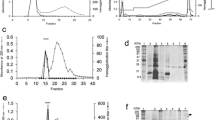Abstract
In order to localize the ‘anixiopsin’, a lectin of the keratinolytic fungus Anixiopsis stercoraria, the authors used a monospecific antiserum prepared by immunization of rabbits with their own erythrocytes coated in vitro with ‘anixiopsin’. In light and scanning electron microscopies, lectinic sites were visualized by means of latex microspheres sensitized with anti-rabbit IgG antibodies. In transmission electron microscopy using the IgG fraction of the rabbit anti-anixiopsin immune sera and protein A-gold, ‘anixiopsin’ seemed mainly present on the outermost cell wall layer of the ascospores, in a pseudomembraneous structure dense to electrons. Implications of these results on physical and biological properties of the lectin are discussed.
Similar content being viewed by others
References
Bendayan M. Protein A-gold electron microscopic immunocytochemistry: Methods, applications and limitations. J Electr Micr Tech 1984; 1: 243–270.
Blank F. Chemical composition of the cell wall of dermatophytes. Biochim Biophys Acta 1953; 10: 110–13.
Borrebaeck CAK, Mattiasson B, Nordbring-Hertz B. A fungal lectin and its apparent receptors on a nematode surface. FEMS Microbiol Lett 1985; 27: 35–39.
Bouchara JP, Robert R, Chabasse D, Senet JM. Evidence for the lectin-nature of some dermatophyte haemagglutinins. Ann Inst Pasteur/Microbiol 1987; 138: 729–736.
Chabasse D, Bouchara JP, De Bievre C. Flore fongique des bacs à sable, mise en évidence, signification. Mycopathologia 1985; 90: 3–13.
Chabasse D, Robert R. Detection of lectin from Chrysosporium keratinophilum (Frey) Carmichael and Anixiopsis stercoraria (Hansen) Hansen by inhibition of haemagglutination. Ann Inst Pasteur/Microbiol 1986; 137B: 187–93.
Jansson HB, Nordbring-Hertz B. The endoparasitic nematophagous fungus Meria coniospora infects nematodes specifically at the chemosensory organs. J Gen Microbiol 1983; 129: 1121–26.
Jones BE, Gooday GW. Lectin binding to sexual cells in fungi. Biol Chemical Soc Trans 1977; 5: 717–19.
Nordbring-Hertz B, Friman E, Mattiasson B. A recognition mechanism in the adhesion of nematodes to nematodetrapping fungi. In: TC Bog-Hansen eds. Lectins-Biology, biochemistry and clinical biochemistry. W De Gruyter, Berlin, 1982; 2: 45–50.
Nordbring-Hertz B, Mattiasson B. Action of a nematodetrapping fungus shows lectin-mediated host-microorganism interaction. Nature 1979; 281: 477–79.
Quash GA, Roch AM, Niveleau A, Grange J, Keolouangkhot I, Huppert J. The preparation of latex particles with covalently bound polyamins, IgG and measles agglutinins and their use in visual agglutination test. J Immunol Meth 1978; 22: 165–74.
Ripoll JP, Roch AM, Quash GA, Grange J. An automatic continuous flow method for the determination of antipolyamine antibodies in human sera. J Immunol Meth 1980; 33: 159–73.
Sequeira L. Lectins and their role in host-pathogen specificity. Ann Rev Phytopathol 1980; 16: 453–81.
Author information
Authors and Affiliations
Rights and permissions
About this article
Cite this article
Chabasse, D., Robert, R., Tronchin, G. et al. Ultrastructural localization of ‘anixiopsin’: a lectin of the fungus Anixiopsis stercoraria (Hansen) Hansen. Mycopathologia 103, 81–85 (1988). https://doi.org/10.1007/BF00441262
Accepted:
Issue Date:
DOI: https://doi.org/10.1007/BF00441262




